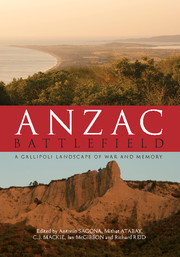Book contents
- Frontmatter
- Foreword
- Contents
- Figures
- Plates
- Contributors
- Acknowledgements
- Abbreviations
- Gallipoli battlefield place names
- Introduction
- 1 Boundary and divide: The antiquity of the Dardanelles
- 2 The Gallipoli campaign: History and legend
- 3 Recording the battlefield: First steps
- 4 Capturing the battlefield: Mapping and air photography at Gallipoli
- 5 Battlefield archaeology: Gallipoli
- 6 Forming the ANZAC battlefield
- 7 Forming the Ottoman battlefield
- 8 Artefacts from the battlefield
- 9 Remembering Gallipoli
- 10 Remembering Gallipoli from a Turkish perspective
- Conclusion
- Appendix Anzac Gallipoli Archaeological Database
- References
- Index
Introduction
Published online by Cambridge University Press: 05 December 2015
- Frontmatter
- Foreword
- Contents
- Figures
- Plates
- Contributors
- Acknowledgements
- Abbreviations
- Gallipoli battlefield place names
- Introduction
- 1 Boundary and divide: The antiquity of the Dardanelles
- 2 The Gallipoli campaign: History and legend
- 3 Recording the battlefield: First steps
- 4 Capturing the battlefield: Mapping and air photography at Gallipoli
- 5 Battlefield archaeology: Gallipoli
- 6 Forming the ANZAC battlefield
- 7 Forming the Ottoman battlefield
- 8 Artefacts from the battlefield
- 9 Remembering Gallipoli
- 10 Remembering Gallipoli from a Turkish perspective
- Conclusion
- Appendix Anzac Gallipoli Archaeological Database
- References
- Index
Summary
This book deals with the transformation of the Anzac landscape at Gallipoli. We seek to explain how a rugged piece of land, remote and overlooking the Aegean Sea, was quickly and dramatically turned into a scene of intense conflict on 25 April 1915. Within eight months Allied and Ottoman forces changed this land, which is actually quite small in size, into a battleground, scarring it with a complex labyrinth of military earthworks. Then, a few years after the conflict ceased, silence descended upon it once more. Gallipoli entered its third stage of development, as a cemetery – the last resting place for thousands of soldiers who lie buried within its soil.
In terms of preservation, no other First World War battlefield can match Anzac. Whether trenches or tunnels, dugouts or terraces, much of the Anzac battlefield still survives beneath a canopy of vegetation. Battered by cold northerly winds in winter, which often bring with them copious quantities of rain, this coastal fringe and its hinterland have suffered much erosion over the last hundred years, as any comparison with photographs will show. Even so, this fragile site endures. Despite the fact that more than one million people visit the battleground each year as tourists and pilgrims, there is as yet little ‘development’ in the modern sense of that word. Reference to other coastal locations in the west of Turkey, such as Bodrum, reminds us just how well preserved the battlefields actually are. You can stand at Lone Pine today looking south towards Cape Helles and scarcely see a building or structure of any kind.
Violence and aggression extend back to the very roots of humanity. Long before any written records, prehistoric warfare conducted by stateless societies has been attested many times over by archaeologists working in every corner of our planet. Five thousand years ago, when writing was invented, conflict became a continuous feature of literature and religion. Yet, in all instances of conflict before the First World War, the scope was localised, even if the motives and the trauma it caused victims still resonate in today's hostilities. The First World War was something quite different. It ushered in war that was both global in scale and industrial in its operations.
- Type
- Chapter
- Information
- Anzac BattlefieldA Gallipoli Landscape of War and Memory, pp. 1 - 3Publisher: Cambridge University PressPrint publication year: 2016



